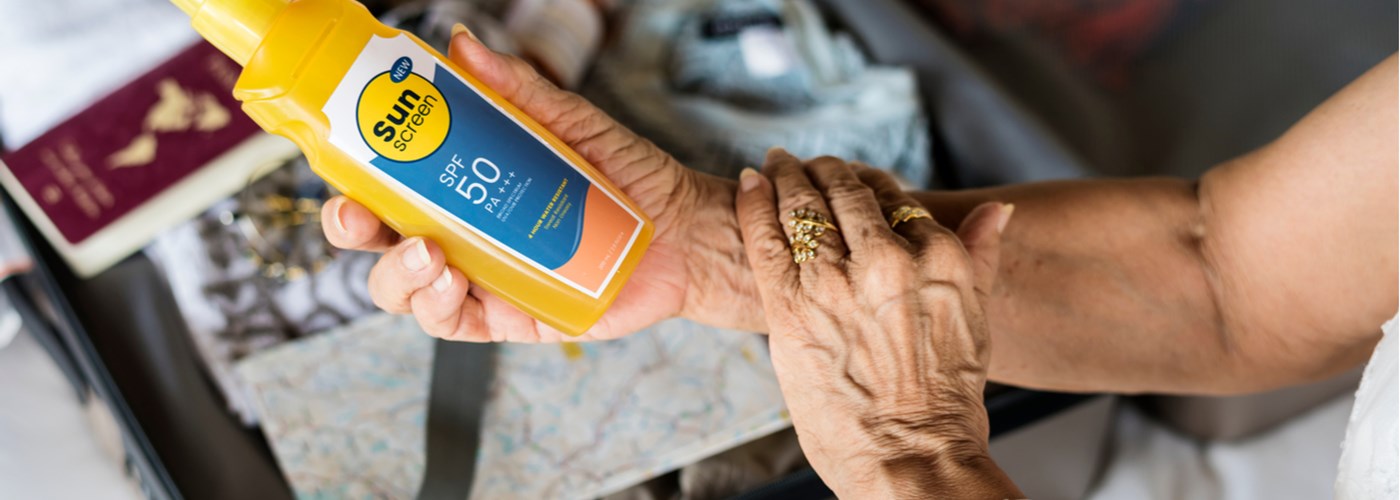SPF Factors Explained
It needn’t be a sweltering day to feel the full force of the sunshine. Even in overcast conditions, sunlight remains extremely strong, penetrating clouds and even glass.
And with that sunlight, come plentiful supplies of UV rays. These can covertly and very gradually damage the skin, cause wrinkles, and increase the chance of developing skin cancer, especially if skin is over-exposed and under-protected.
While we won’t be suggesting you avoid the sun completely or give up that golden tan, you can minimise the risk of sun damage by getting to know what’s on your sun cream bottle, and what that means for your sun protection.
Take a look at our top tips below about what SPF means, how SPF works, and how often you should apply sun cream.
Understanding your sunscreen bottle
What does the SPF number mean?
SPF stands for sun protection factor which acts as a yardstick for the length of time the sun’s UV radiation will take to burn your skin versus if you were unprotected.
For example, if you’re wondering how long SPF 30 lasts, it should take you 30 times longer to burn than if you were wearing no sun cream, as it allows around 3% of UVB rays to reach your skin. Likewise, how long does SPF 50 last? Well, it would take 50 times longer to make you burn and allows around just 2% of UVB rays through. This only applies, of course, if you are applying sun lotion as directed on the bottle and reapplying as instructed.
What does UVA and UVB mean?
Beyond what SPF means, your sun lotion bottle provides much more vital info about its sun protection level, including the differences between UVA and UVB.
UVA (ultraviolet A) penetrates the skin more deeply than UVB and has a longer-lasting effect. These types of rays are closely linked with skin cancer and premature ageing, such as wrinkles, leathery skin, and sun spots. UVB (ultraviolet B) has shorter wavelengths than UVA and is more commonly displayed on sun cream bottles; it is also the main cause of sunburn and is linked with some skin cancers.
Where is the expiry date on sun cream?
Not had a chance to buy new sunscreen this summer? Are you wondering how long sun cream lasts as you’re looking to apply last year’s bottle?
To know when suncream expires, all you need to do is look out for the symbol that looks like an open jar on the sunscreen bottle. This has a number inside that tells you how long the product should be used after it has been opened.
For example, if you see “12M” in the open jar, then the sun cream should be used within 12 months of cracking it open. After that time, the sun cream becomes ineffective – no matter how high the sun protection factor is. As such, try to remember when you last opened it and, if you know you used it last year, it’s time to buy a fresh one.
How often should I apply sun cream and how much should I be wearing?
While many dermatologists will recommend wearing sun cream everyday to provide constant sun protection (yes, even during the winter), during summer, when the sun is at its hottest, you should consider reapplying sun lotion every two hours. If you are out and about during the hottest point of the day, have sensitive skin, go swimming, or sweat a lot, you may need to increase the frequency.
As for how much sun cream you should apply, the World Health Organisation (WHO) recommends 35ml (around seven teaspoons) for all over body coverage. This amount of sun cream should cover a teaspoon on the head and neck, one teaspoon on each arm, each leg, your front, and your back.
Generally, we don’t apply enough sun cream to our bodies which means, while we think we’re doing everything we can to protect our skin, we could be greatly reducing our level of sun protection. If in doubt, apply more, not less.
What SPF should I use?
It goes without saying that, for maximum sun protection, a higher SPF is advised.
There are some conflicting recommendations in the UK, however, about what is the best sun cream for sun protection. The NHS and Cancer Research UK, for instance, recommend an SPF of at least 15 while the British Association of Dermatologists suggest at least SPF 30.
The decision comes down to what you know about your skin. Are you prone to burning at the first sight of sun? Is your skin pale? Have you any skin conditions? If you know your skin has a low tolerance to sun exposure, it is always better to be over-cautious with sun protection and opt for a higher SPF, even if it is cloudy.
Other than sun protection factor, what else should you be looking for on your sunscreen bottle? Water-resistant sun creams are most effective as they are able to wick away sweat, rain, and swimming water. Sprays don’t always play well with windy weather and tanning oils – which develop a deeper tan through attracting more UVB rays – will deepen your chance of burning.
Also don’t forget to consult the UVA and UVB ratings on the bottle when choosing between sun creams: they should say ‘high’ or ‘very high’ or provide a star rating of 4 or more (the higher the rating, the better).
For more helpful information about looking after your skin and general wellbeing advice, visit our Be Healthy hub where you will find guidance and practical tips on staying safe in the sun, outdoor fitness ideas and more.
Medically reviewed by Llinos Connolly on May 2023.

